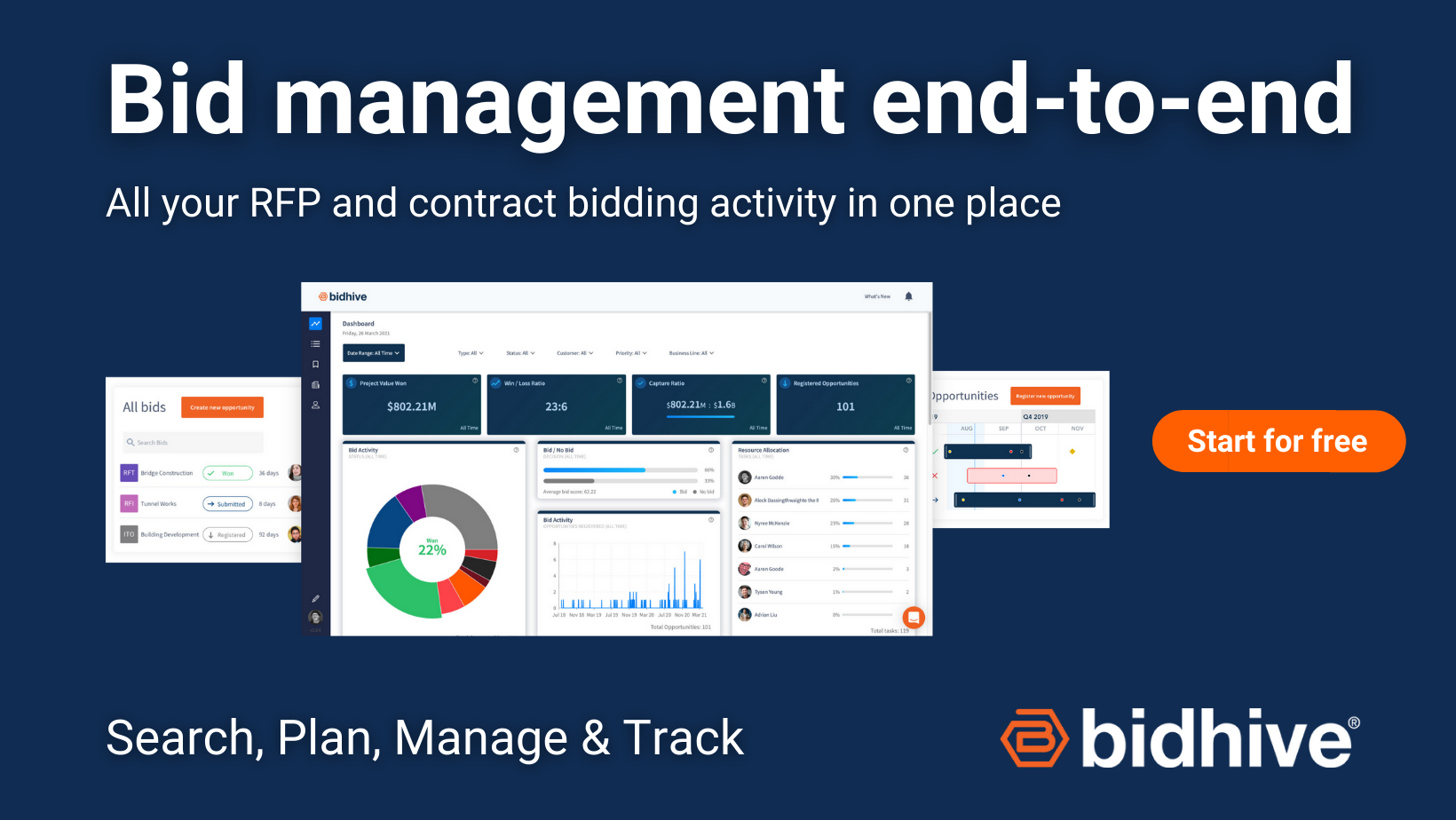When an organisation pursues a bid opportunity it will invest significant time, cost and resources to win the contract. Therefore, the assessment, qualification, prioritisation and selection of the right opportunities is a critical decision that has direct correlation to business success.
The bid/no bid decision however, is complex and uncertain due to changing dynamics including subjective evaluation, the nature of the project or contract, market forces and company aspirations. To aid the bid/no bid decision making process, a bid/no bid model for weighting categories and factors can be used to provide more reliable results.
Introduction
For many companies, participating in the competitive bidding process is vital for building their position in the market and securing a pipeline of work in uncertain times.
Mid to high cap public companies; multinational private entities with diversified portfolios and those operating in highly regulated industries rely on securing a high proportion of their contract revenue through the bidding process. Small to medium enterprises have less dependency on contract bidding, however for some it is a strategic growth opportunity, earning them between 10-40% of their revenue. New diversity and inclusion policies in procurement is also opening up new opportunities for SMEs to compete for contracts that are well within their reach.
With contract sizes becoming smaller and the supply chain more fragmented, the decision to pursue a procurement bidding opportunity is a complex one. Losing or forgoing an opportunity can damage reputation or lock the company out until the next contract re-bid (which can be 3-5 years); but making the wrong decision might place financial and resource stress on the organisation if they can’t service the contract with the right resources; have immature project management or contractor management processes; or haven’t factored in enough profit margin over the life of the contract for example.
The paradox of choice: revenue versus serviceability in uncertain times
As many commercial and industrial enterprises move quickly to adapt to market and workforce changes, they face the paradox of choice between balancing the need for new revenue streams versus the practicalities of finding the scale, resources and infrastructure to successfully operate in a climate of restricted movement and disrupted supply chains. When new business is the lifeblood of an organisation, building (or rebuilding) the capability and capacity to win and service a contract is a critical decider.
A bid/no bid decision will help organisations move from a shot-gun approach to a more rational decision-making process where budget, original thinking and resources need to be directed appropriately.
The bid/no bid decision: when to say yes and when to say no
The most successful strategies to win a bid is to begin by filtering out opportunities to concentrate on opportunities that will have the highest probability of winning and translating to successful contract delivery.
It is important to know that there is no single nor right or wrong approach for a bid/no bid decision, and many companies customize their assessment questions and scoring tailored to their company’s decision criteria. They may also choose different assessment methods and criteria depending on their business or service lines, customer size, and the value of the opportunity.
A bid/no bid model that captures common key factors as well as different judgments from decision makers combined into one final decision – as opposed to a single person’s gut feel – can be achieved to identify the most beneficial opportunities for the company.
This model will often include a combination of capability and contract-specific criterion, along with risk factors that impact on the execution of corporate strategy.
Building a bid/no bid model
Any organisation that has previously had an unstructured decision making process will not want their model to be too rigid, but to serve as a tool for improved transparency, reliability and replicability of decisions. Important to this process is enabling decision makers to be entrepreneurial in extraordinary circumstances, and having a tool that is flexible enough to be tailored to company’s own dynamics.
Bid/no bid models to aid in rational decision making can be built in a number of ways using different structures and methodologies, including the multi-attribute decision-making approach; artificial intelligence-based; and statistical modelling. These models share the common goal of working to identify the most beneficial opportunity for the organisation for the short and long term.
Whilst bid/no bid decision checklists are commonly used and ask the right questions, often the answers aren’t leveraged to inform future bid decisions. An improvement on this method is multi-attribute decision-making. This simple model is easy to develop and implement due to its ability to accommodate a wide range of criteria on different scale types that can be transformed into weighted criteria. There is also the ability to change factors and apply the tool to other lines of business within a diversified business.
This bid/no bid methodology might not be applied to every bid, but it could be recommended, or officially adopted above a certain threshold, such as a minimum contract value where risk is higher.
Step 1. Set the threshold
The risk threshold for a bid/no bid decision quantifies an organisation’s tolerance for risk as a quantifiable figure. Depending on an organisation’s risk appetite, this figure can be a set number, or there may be tolerance for an acceptable variance (eg. 5-10% range). The threshold sets the limit beyond which the organisation will not accept the risk. Results falling either side of the threshold will inform the bid/no bid recommendation.
Step 2. Validate mandatory requirements
A multi-attribute bid/no bid method can accommodate a wide range of criteria on different scale types and allow preference information to be transformed into weighted criteria. To ensure a company doesn’t waste time and resources on an opportunity qualifying that you will pass the minimum eligibility criteria (yes/no or pass/fail), including a conflict of interest search should be undertaken up front.
Owing to the high risk and cost of bidding, bid documents, and the ultimate decision around eligibility is usually filtered and evaluated by experienced personnel with years of bidding experience.
Step 3. Create your factors
Because of a multi-attribute model’s ability to use both quantitative and qualitative data, weightings and the possibility of a large number of criteria, the tools can be used to build discrete decision criteria (or factors). These can be tailored to lines of business, or to opportunities that vary from project to project where no single criteria or uniform weighting neatly fits the unique situation or requirements.
Factors are usually categorised and grouped by internal (organisational-related) and external (contract and project related) considerations including:
- Internal: current workload, track record, financial capacity, need for work, technical know-how, alignment to corporate strategy
- External: contract/project size, duration of work, location of the work, work type, contract conditions and type of contract, and customer profile and reputation.
For illustrative purposes, we have presented an example of a framework highlighting commercial, strategic and practical factors with the most influence and relative significance to bid and contract success.
| Company related internal factors | |
| Current workload | Commitment and capacity to resource the bid, and the resulting contract if we win |
| Previous track record and experience | Demonstrated experience working for similar types of customers doing similar work |
| Financial capacity | Financial capacity to bid and service the contract including cash reserves and working capital
|
| Need for work | Our company’s commitment to winning the bid for longer-term continuity of workforce employment |
| Technical knowhow | How well our company matches the technical skills and experience requirements |
| Alignment with company’s corporate strategy | How well the contract deliverables fit with our company’s core competencies, business strategy (short-term direction and future vision) |
| Future opportunities | Degree to which the opportunity may open up new market and new customers |
| Contract / project related external factors | |
| Contract value | Contract value represents the minimum percentage of current company turnover and profit margin |
| Contract or project benefits | Contract may improve reputation, help to enter new markets and/or increase experience of personnel |
| Contract duration | The likely impact of the contract duration on existing workforce capacity |
| Project/contract implementation | Ability to deliver the contract with the right people and experience (including sub-contractors, partners and location of where the contract needs to be serviced) |
| Contract type and conditions | Degree of rigidity of specifications and contract conditions (including ability to modify) |
| Customer identity | Customer reputation and alignment with our company’s values, vision and mission. |
| Competition | Strength of our company compared to potential competitors (relationship with customer, solution, pricing) |
There are no magic number of factors you should choose and they will vary across industries and different market conditions. However, a comparison of international studies reveal that 14 to 18 factors is a fairly standard guide for construction companies whereas professional services will likely have less.
Additionally, more complex bids such as those in international markets and/or the construction sector where risk and cost is high might include a multistage sequence (or ‘gates’) rather than one singular decider step. These bids might consider country and/or market risk vulnerability, company performance, profitability and probability of winning based on specific scope of work.
Step 4. Assessing and ranking relative importance of the bid/no bid factors
Once the categories and factors have been selected, the organisation needs to rank them and identify their weights of importance in line with the organistion’s characteristics and strategies. This might include, for example, the relative importance against competitor offerings. Each factor is then scored, and a final overall score is generated.
This approach to weighting and ranking provides a more rational basis upon which to make the decision and ultimately, improve the accuracy level of the organisation’s assessment.
Step 5. Who makes the bid/no bid decision?
It is important to involve bid and delivery teams in the bid/no bid process, with ultimate executive decision making at the bid committee and/or delegated level. Bid and delivery teams have combined market knowledge about competition and experiences, as well as having sales insight on the customer. Subject matter experts bring knowledge of the approach and solutions while project managers have knowledge of timelines and resource availability. Legal personnel can also bring expertise around contractual conditions.
Introducing different perspectives and input into the bid/no bid assessment reduces bias, and can also uncover broader insights on risk perception that might otherwise have been overlooked. Important to the process is the ability to override the model’s recommendation with a supporting business case for a decision. Ultimately, gaining consensus is key to the successful business operations and the team work involved in bidding and contract delivery, especially if the bid decision is a strategic one.
Practical benefits and implications
Utilizing bid/no bid techniques such as the multi-attribute model and tools which combine market analysis and historical decisions along with supporting rationale has several advantages:
- The method gives bidding companies more objective and reliable results. The range of values delivers a clearer picture of the probability of bidding success so that the bid/no-bid decision is less biased.
- The method speeds up the bid/no-bid decision process. With a simple and systematic structure where limited training is required, bidding companies can more quickly and consistently evaluate and weight based on a set of clear terms, or factors.
- The method can deliver cost savings by either reducing the time it takes to prepare the proposal (up to 15% to 20%), or allowing for more time to spend on preparing higher quality proposals by allocating optimum bidding resources to improve the win ratio.
Whilst the bid/no bid decision is greatly influenced by organisational size and financial resourcing, improved knowledge and understanding of bid/no bid factors and the scoring methodology can provide more convincing and reliable results that reduce risk and deliver cost savings for a company in the long run.
Use of the tool can also reveal decision makers’ subjective preferences which can be useful for diagnosing bias. Where there is a decision dilemma the tool can be run independently across multiple decision makers and the results can be compared to support a final bidding decision.
Technology advancements to the bid/no bid process
An advancement on current bid-no bid decision model that we are working on is the closed loop process which solves the dilemma of inaccurate results. This loop learns from hindsight enabled by machine learning/artificial intelligence to deliver predictive analytics to rank opportunities, determine win probability and highlight strategic differentiators. By analysing historical data, companies can better identify which bids they should be going after based on aggregated trends data, and insights from lessons learned and post-bid debriefs. Over time this model can extend variables to contract KPIs.
An enabler to this process is the methodological completion of other key steps in the end-to-end process, including capture plan and post-bid reviews which should take learnings from failed projects as well as from successful projects. By aggregating and analysing historical data from end-to-end of the bid lifecycle we can correlate bid scores to project success to arrive at an optimum process that helps organisations to secure their competitive position to increase win rates and importantly, their profit margin without leaving money on the table.

Enter your email to unlock this content
If you'd like to read this locked content in full just enter your email and click unlock.
It's as simple as that.
And we promise we won't bombard you with emails and newsletters.
Sure we might send you one every now and then.
But it's ok... you can opt out at any time.
Unlocked!







